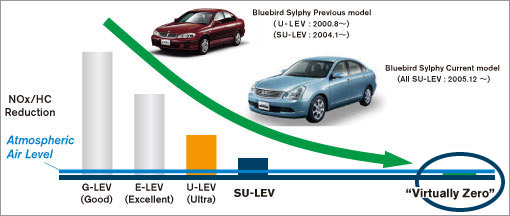Minimizing emissions to preserve the atmosphere, water and soil
We are putting more effort into our existing initiatives to protect the atmosphere, water and soil and energetically seeking out improvements at every stage.
From the product design stage to market introduction, we are promoting environmental preservation at every stage of the process
Nissan has already set strict internal standards concerning water drainage and chemical waste disposal at its plants. These standards apply to every aspect of the vehicle development, from the production process to the design and engineering to meet gas emission regulatory standards. In catalytic technologies to minimize exhaust gas emissions, for example, Nissan is currently ranked in the top class. We are also pursuing initiatives to reduce the environmental burden at our production plants worldwide.
Energetic promotion of reducing exhaust gas emissions aimed at healthy atmospheric levels
Nissan has made significant progress in developing cleaner combustion and catalytic technologies. In January 2000, the Sentra CA was launched in the U.S. and became the world's first gasoline-powered car to meet the rigorous PZEV* emissions standards set by the California Air Resources Board. In August 2000, the Bluebird Sylphy was the first passenger car in Japan to obtain U-LEV (ultra low emission vehicle) certification from Japan's Ministry of Land, Infrastructure and Transport. In 2003, with the introduction of the new super-low emission vehicle (SU-LEV) classification, the Bluebird Sylphy again gained distinction as Japan's first SU-LEV certified vehicle.
Over 80% of Nissan's passenger cars sold in Japan meet the SU-LEV standard for exhaust gas emissions. Based on our calculations, this has cut emissions - NOx and hydrocarbons - to levels equivalent to having 40% of the vehicles on the road as fuel cell vehicles (FCVs) or electric cars (EVs).
Nissan's ultimate goal is to reduce exhaust gases to a level that is lower than any applicable ambient air regulation or standard. We will continue to develop cars that emit fewer exhaust gases.

* PZEV stands for Partial Zero Emission Vehicle, as certified by the California Air Resources Board.
We have already met industry targets for reducing VOCs in car interiors
Volatile organic compounds, or VOCs, are organic compounds such as formaldehyde and toluene that are volatile.
In Japan, the Ministry of Health, Labor and Welfare (MHLW) has defined industry guidelines for car interior concentration of certain VOC substances in new passenger cars from fiscal 2007 onward.To reduce the VOCs, Nissan has studied the materials and adhesives we use in components such as seats, door trim and floor carpets.
Nissan has met the MHLW guideline for new models and those undergoing minor model changes from fiscal 2005 in Japan. We will be introducing products meeting the MHLW guideline globally, starting July 2007.
|